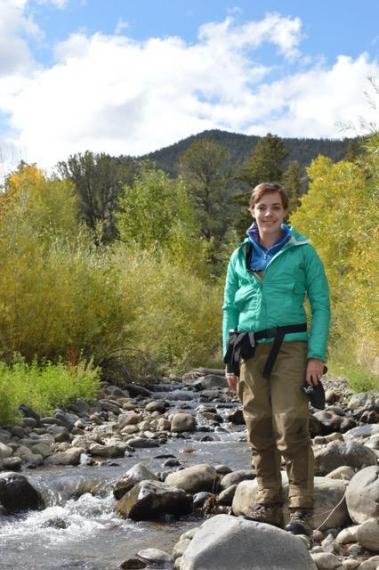Elizabeth Mandeville

I study hybridization, speciation, and genetic structure of natural populations of fish using computational approaches, and am particularly interested in how and why evolutionary processes vary through space and time. I use genomic and ecological data to better understand evolutionary and ecological interactions between species. Much of my research has direct applications in fish conservation genomics, and involves collaboration with fisheries management agencies. I also enjoy learning and teaching new computational approaches and programming languages, and am interested in effective visualization of multidimensional scientific data.
BS, Yale University, 2009
PhD, University of Wyoming, 2016
My research is motivated by quantifying variation in evolutionary and ecological processes that generate and maintain biodiversity. I study evolution in heterogeneous environments, over large geographic ranges, and in the presence of variable species assemblages by using computational approaches and bioinformatics techniques to analyze large, high-resolution genomic datasets. I focus on how evolutionary processes influence genomic variation in fish, how consistent the outcomes of these processes are, and how ecological traits of organisms and environmental attributes of rivers and lakes can a↵ect the outcomes of evolutionary processes. Species are maintained as discrete genetic units by reproductive isolation between species, but species distinctiveness can also be countered by hybridization and introgression. Populations within a species experience analogous processes. Gene flow maintains similarity, but barriers to dispersal, genetic drift, and local adaptation promote differentiation. My work revolves around two focal questions:
- How consistent are evolutionary and ecological outcomes of species interactions?
- To what extent are species evolutionarily cohesive across their ranges?
Most of the fish species I study are affected by human-mediated disturbances, including species introductions and fragmentation of aquatic habitat by dams. I use large genomic, ecological, and isotopic datasets to understand how evolutionary processes function across ecological contexts.
Tabak, M.A., M. Norouzzadeh, D. Woflson, S. Sweeney, K. Vercauteren, N. Snow, J. Halseth, P. Di Salvo, J. Lewis, M. White, B. Teton, J. Beasley, P. Schlichting, R. Boughton, B. Wight, E. Newkirk, J. Ivan, E. Odell, R. Brook, P. Lukacs, A. Moeller, E.G. Mandeville, J. Clune, and R. Miller. Online Early View. Machine learning to classify animal species in camera trap images: applications in ecology. Methods in Ecology and Evolution.
Mandeville, E.G., T.L. Parchman, S.J. Song, K.G. Thompson, R.I. Compton, K.R. Gelwicks, and C.A. Buerkle. 2017. Inconsistent reproductive isolation revealed by interactions between Catostomus fish species. Evolution Letters, 1: 255–268.
Gompert, Z., E.G. Mandeville, and C.A. Buerkle. 2017. Analysis of Population Genomic Data from Hybrid Zones. Annual Review of Ecology, Evolution, and Systematics, 48: 207–229.
Wagner, C.E, and E.G. Mandeville. 2017. Speciation, species persistence and the goals of studying genomic barriers to gene flow. Journal of Evolutionary Biology, 30: 1512–1515.
Underwood, Z., E.G. Mandeville, and A.W. Walters. 2016. Population connectivity and genetic structure of burbot populations in the Wind River Basin, Wyoming. Hydrobiologia, 765: 329–342.
Mandeville, E.G., T.L. Parchman, D.B. McDonald, and C.A. Buerkle. 2015. Highly variable reproductive isolation among pairs of Catostomus species. Molecular Ecology, 24: 1856–1872.